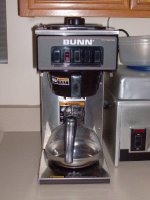I have a small, single serving Black and Decker Brew & Go; here's a picture although you can imagine it, I assume.
http://www.blackanddeckerappliances.com/c-9-personal.aspx
Theoretically, you can pour water into the resevoior in the back to heat water for tea and/or oatmeal. However, practically speaking, the tastes sort of combine and I'm getting complaints from my kids about that.
(I don't mind doing a Vinegar Cleansing Wash every so often, but they use the Brew & Go in tandem so that doesn't help.)
So, it's being discussed if we should invest in a plug in sort of kettle or hot pot. It's not a lot of money and I guess I can find the room to store it; I just wonder if I'm sort of indulging the kids because neither dh nor I really need such a thing - we have a stove and microwave and dh and I find that's plenty to own.
I guess the main thing is that when I was their age I was on my own, not living with my parents and asking them for appliances .....
Or, does anyone have a coffeepot that also brews hot water, and doesn't mix up the taste? I mean, our coffee thingy is fine but it's not new and maybe therein lies the problem ....
Thanks all !
http://www.blackanddeckerappliances.com/c-9-personal.aspx
Theoretically, you can pour water into the resevoior in the back to heat water for tea and/or oatmeal. However, practically speaking, the tastes sort of combine and I'm getting complaints from my kids about that.
(I don't mind doing a Vinegar Cleansing Wash every so often, but they use the Brew & Go in tandem so that doesn't help.)
So, it's being discussed if we should invest in a plug in sort of kettle or hot pot. It's not a lot of money and I guess I can find the room to store it; I just wonder if I'm sort of indulging the kids because neither dh nor I really need such a thing - we have a stove and microwave and dh and I find that's plenty to own.
I guess the main thing is that when I was their age I was on my own, not living with my parents and asking them for appliances .....
Or, does anyone have a coffeepot that also brews hot water, and doesn't mix up the taste? I mean, our coffee thingy is fine but it's not new and maybe therein lies the problem ....
Thanks all !





